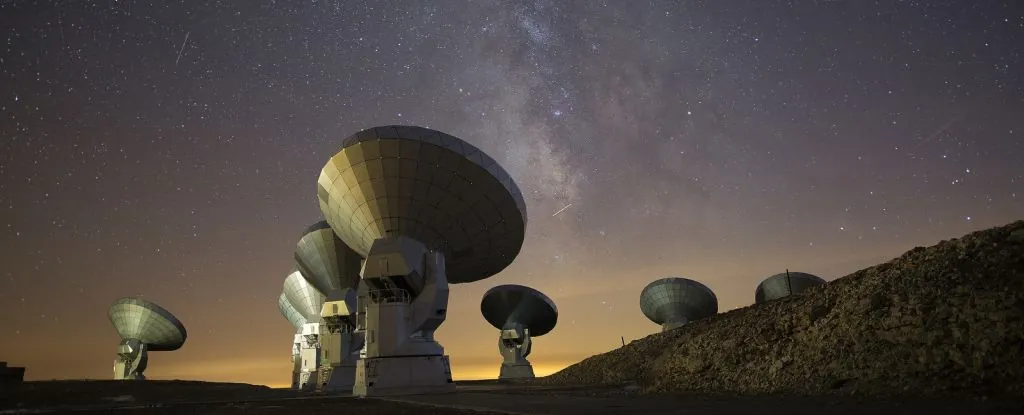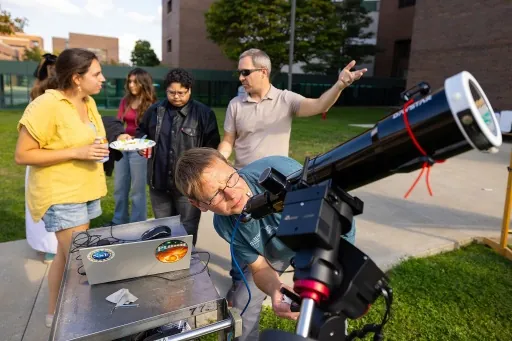
Mysterious 'Einstein Cross' in Space Unveils Hidden Dark Matter Secrets
2025-09-20
Author: Noah
A Cosmic Surprise: The Einstein Cross Phenomenon
In a stunning twist of cosmic fate, a rare configuration of celestial objects known as the Einstein Cross has just exposed the elusive location of a colossal blob of dark matter in the universe.
The Unprecedented Find: HerS-3's Fifth Light Source
Typically, an Einstein Cross consists of four distinct points of light, but this extraordinary example, dubbed HerS-3, reveals a peculiar fifth source of light at its center—a cosmic anomaly that has left scientists astounded.
Theoretical astrophysicist Charles Keeton from Rutgers University explains, "That's not supposed to happen. You can't get a fifth image in the center unless something unusual is occurring with the mass bending the light."
How Einstein Crosses Work: A Dance of Light and Gravity
Einstein Crosses are remarkable cosmic phenomena created by the distortion of spacetime caused by immense gravitational fields. When light from a distant galaxy passes through this warped spacetime, it splits into four images, forming a cross pattern. Normally, the center remains void of any image, as any light seen there would usually belong to a foreground object.
Discovering HerS-3: A Galaxy from 11.7 Billion Years Ago
HerS-3, located near the edge of the observable universe, is a star-forming galaxy emitting light that has traveled an astonishing 11.7 billion years to reach us. Astronomer Pierre Cox and his team from the French National Center for Scientific Research found something unexpected—a fifth mysterious light source located at the center of this cosmic cross.
Cox recalls their reaction, stating, "We were like, 'What the heck?' It looked like a cross, and there was this image in the center. I knew I had never seen that before."
Investigating the Mystery: Dark Matter Unveiled
Initially, researchers questioned whether the fifth image was due to a glitch, but upon conducting extensive computer modeling, they ruled out all potential explanations involving visible galaxies. They ultimately concluded that this bizarre phenomenon must be linked to dark matter.
Keeton noted, "We tried every reasonable configuration using just the visible galaxies, and none of them worked. The only way to reconcile the math was to include a dark matter halo. That's the power of modeling—it reveals what remains hidden."
The Enigma of Dark Matter: A Key to the Universe
Dark matter is one of the universe’s greatest mysteries, existing only through its gravitational effects. While we've confirmed its existence due to the overwhelming gravity present, its nature remains elusive. The Einstein lensing effect of HerS-3 provides crucial insights into this enigmatic substance.
A Window to the Past: Understanding Early Galaxy Formation
Researchers proposed that a closer group of galaxies, whose light has been traveling for approximately 8 billion years, interacts with a massive dark matter halo, resulting in the magnificent Einstein ring observed.
This exceptional finding allows astronomers to attain closer views of a star-forming object from a time when galaxies were too faint to observe, while also enabling the study of both the nearby galaxy group and the properties of the dark matter halo itself.
Unlocking Cosmic Mysteries: The Significance of HerS-3
The HerS-3 system stands as a unique astrophysical laboratory, shedding light on a nearly edge-on dusty starburst galaxy at a crucial point in cosmic evolution. As researchers note, it paves the way for further exploration into the characteristics of galaxy group lensing and the substantial dark matter halo associated with it.









 Brasil (PT)
Brasil (PT)
 Canada (EN)
Canada (EN)
 Chile (ES)
Chile (ES)
 Česko (CS)
Česko (CS)
 대한민국 (KO)
대한민국 (KO)
 España (ES)
España (ES)
 France (FR)
France (FR)
 Hong Kong (EN)
Hong Kong (EN)
 Italia (IT)
Italia (IT)
 日本 (JA)
日本 (JA)
 Magyarország (HU)
Magyarország (HU)
 Norge (NO)
Norge (NO)
 Polska (PL)
Polska (PL)
 Schweiz (DE)
Schweiz (DE)
 Singapore (EN)
Singapore (EN)
 Sverige (SV)
Sverige (SV)
 Suomi (FI)
Suomi (FI)
 Türkiye (TR)
Türkiye (TR)
 الإمارات العربية المتحدة (AR)
الإمارات العربية المتحدة (AR)